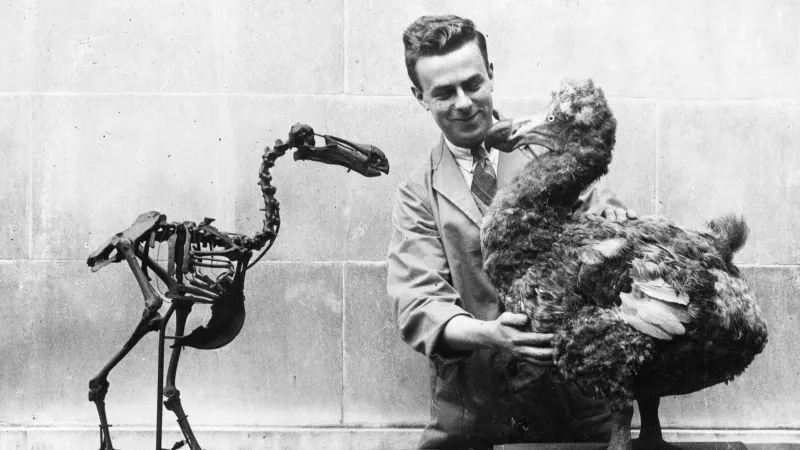
The Race to Revive Extinct Species: Are We Ready for ‘Resurrection Science’?
2025-01-16
Author: Jessica Wong
The Intriguing Concept of ‘De-extinction’
The intriguing concept of ‘de-extinction’ is gathering momentum as advances in genetic engineering and synthetic biology push the boundaries of what might be possible in the realm of wildlife conservation. With the promise of reviving extinct species like the woolly mammoth, the dodo, and the Tasmanian tiger, the age of resurrection science could be on the horizon.
Recent Developments
Recent developments have been promising. Colossal Biosciences, the Dallas-based biotech company spearheading these ambitious projects, recently announced the successful raise of an additional $200 million in funding, bringing their total investment to an impressive $435 million since their inception in 2021. Founded by entrepreneur Ben Lamm and Harvard geneticist George Church, this company is determined to change the narrative of species extinction.
Excitement and Controversy
In less than a decade, we might witness the return of creatures that have only existed in memory or through historical artifacts — a development that has sparked both excitement and controversy among scientists, ethicists, and conservationists alike.
Proponents' Perspective
Proponents of these efforts argue that reviving extinct species could usher in a new era of conservation funding, appealing to wealthy investors and creating a high-tech solution to biodiversity loss. These researchers believe that advances made in resurrecting lost species could also provide insights and tools necessary to protect endangered species that are still with us, especially as the climate crisis threatens ecosystems worldwide.
Criticism and Ethical Considerations
However, criticism persists regarding the ethical implications and feasibility of such undertakings. Detractors assert that the efforts of wealthy investors may be misaligned, arguing that the funds could be better utilized in preserving existing ecosystems rather than resuscitating species that might be genetically altered imitations of their former selves. Concerns also arise around the potential risks to current biodiversity, as reviving extinct species could disrupt the ecosystems they are introduced into.
The View on 'De-extinction'
Melanie Challenger, deputy co-chair of the Nuffield Council on Bioethics in the U.K., notes that the term ‘de-extinction’ may be misleading. Instead of bringing back extinct species, the processes involved create hybrid organisms that mimic these species but are, in essence, genetically engineered hybrids. She cites ongoing ethical dilemmas associated with such manipulations that need careful consideration as the field advances.
Methods for Reviving Lost Species
So, what methods do scientists have at their disposal to attempt the almost mythical task of reviving the lost? Work in this field primarily revolves around three techniques: cloning, genetic engineering, and back breeding — a selective breeding method that taps into genetics to reintroduce lost traits.
Cloning has provided successful results, such as the remarkable case of Dolly the Sheep, but reviving long-extinct species remains a complex challenge. Grazelands Rewilding in the Netherlands is working to bring back the aurochs, an ancestor of modern cattle, by using selective breeding techniques on domesticated species. Their tauros cattle project has shown promising results in creating an animal with over 99% genetic similarity to the aurochs.
Colossal’s aspiration is even more adventurous, with their plans to resurrect the woolly mammoth by editing the genome of its closest living relative, the Asian elephant. This endeavor has attracted financial support from high-profile investors, including Peter Jackson and Paris Hilton, hoping to back a vision of woolly mammals once again traversing the tundra.
Recent advancements from Colossal include the development of induced pluripotent stem cells (iPSCs), which are vital in creating a genetic foundation for mammoth traits within an Asian elephant’s genome. The journey doesn't end there; Colossal's progress with the Tasmanian tiger has surpassed expectations with considerable genetic editing success on cells from a related marsupial. Meanwhile, efforts to revive the dodo have proven laborious, as these birds’ closest living relatives, Nicobar pigeons, are being used to contribute genetic material for experimentation.
The Need for Transparency
Despite the optimism, the lack of peer-reviewed published work raises legitimate questions regarding transparency in these scientific endeavors. Although Lamm has signaled that they will gradually share their findings with the broader scientific community, the absence of traditional academic scrutiny raises concerns about the accountability of their findings.
Broader Conservation Goals
Colossal’s goals extend beyond de-extinction; they are also funneling resources into conservation efforts aimed at protecting existing endangered species, including initiatives for northern white rhinos and developing health solutions for elephants.
Caution Ahead
While ambitious projects to restore extinct species may hold promise, some experts advise caution. Christopher Preston of the University of Montana argues against the optimism of envisioning herds of hybrids tempering climate change in the Arctic. Simultaneously, Clare Palmer from Texas A&M University raises critical points about the welfare and adaptability of revived species to rapidly shifting ecosystems.
Conclusion: Navigating a New Frontier
As we stand on the brink of a new frontier in conservation, the excitement surrounding 'resurrection science' must be balanced with an awareness of the potential ecological impacts and ethical ramifications of bringing lost species back into our world. While the possibilities spark the imagination, they demand a judicious approach as we navigate the complexities of restoring the past in a changing present.


 Brasil (PT)
Brasil (PT)
 Canada (EN)
Canada (EN)
 Chile (ES)
Chile (ES)
 Česko (CS)
Česko (CS)
 대한민국 (KO)
대한민국 (KO)
 España (ES)
España (ES)
 France (FR)
France (FR)
 Hong Kong (EN)
Hong Kong (EN)
 Italia (IT)
Italia (IT)
 日本 (JA)
日本 (JA)
 Magyarország (HU)
Magyarország (HU)
 Norge (NO)
Norge (NO)
 Polska (PL)
Polska (PL)
 Schweiz (DE)
Schweiz (DE)
 Singapore (EN)
Singapore (EN)
 Sverige (SV)
Sverige (SV)
 Suomi (FI)
Suomi (FI)
 Türkiye (TR)
Türkiye (TR)
 الإمارات العربية المتحدة (AR)
الإمارات العربية المتحدة (AR)